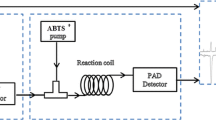Abstract
The aim of this study was to adopt pyrogallol red bleaching test for LC-DAD capable of characterizing chemical constituents and peroxynitrite (ONOO−) scavenging activity in parallel for a large number of plant extracts. The hypothesis is that upon reaction with ONOO−, the peak areas of compounds in complex mixtures with potential radical scavenging activity in the LC chromatograms will be significantly reduced or disappeared. We validated this approach with a model mixture of 17 phenolic compounds, which mimics a general alcoholic extract of Salvia species. The LC separation conditions were optimized for baseline separation of phenolic reference compounds and for selective detection of the test substrate pyrogallol red. The results indicated that the depletion kinetic of compounds in the model mixture correlates moderately with the individual scavenging activities. Moreover, catechol group dependent relationship between the structure–scavenging activity relationships confirmed the LC based assay parameters. The final demonstration of the assay was by methanolic extract of Salvia miltiorrhiza Bunge, which showed outstanding ONOO− scavenging activity. 13 min total analysis time per sample and excellent resolution allow the method to be applied for chemical fingerprinting coupled with rapid screening for natural antioxidants derived from alcoholic extracts of Salvia species.





Similar content being viewed by others
References
Halliwell B, Gutteridge JMC (1999) Free radicals in biology and medicine. Oxford University Press, Oxford
Szabó C, Ischiropoulos H, Radi R (2007) Nat Rev Drug Discov 6:662–680. doi:10.1038/nrd2222
Kooy NW, Royall JA, Ischiropoulos H, Beckman JS (1994) Free Radic Biol Med 16:149–156
Niwa T, Doi U, Kato Y, Osawa T (1999) FEBS Lett 459:43–46
Tsuda T, Kato Y, Osawa T (2000) FEBS Lett 484:207–210
Pannala AS, Singh S, Rice-Evans C (1999) Methods in enzymology, vol 299. Academic Press, New York, pp 207–235. doi:10.1016/S0076-6879(99)99022-5
Tang D, Li HJ, Chen J, Guo CW, Li P (2008) J Sep Sci 31:3519–3526. doi:10.1002/jssc.200800173
Helmja K, Vaher M, Püssa T, Kaljurand M (2009) J Chromatogr A 1216:2417–2423. doi:10.1016/j.chroma.2009.01.040
Balavoine GGA, Geletii YV (1999) Nitric Oxide 3:40–54. doi:10.1006/niox.1999.0206
Clebsch B, Barner CD (2003) The new book of salvias. Timber Press, Cambridge
Jiang RW, Lau KM, Hon PM, Mak TCW, Woo KS, Fung KP (2005) Curr Med Chem 12:237–246
Li YG, Song L, Liu M, Bi-Hu Z, Wang ZT (2009) J Chromatogr A 1216:1941–1953. doi:10.1016/j.chroma.2008.12.032
Reference Substances Catalogue PhytoLab (2008/2009) http://www.phytolab.com
Kenjeric D, Mandic ML, Primorac L, Cacic F (2008) Food Chem 110:187–192. doi:10.1016/j.foodchem.2008.01.031
Lu YR, Foo LY (2002) Phytochemistry 59:117–140. doi:10.1016/S0031-9422(01)00415-0
Hughes MN, Nicklin HG (1968) J Chem Soc A 2:450–452
Ivanov VM, Mamedov AM (2006) J Anal Chem 61:1040–1062. doi:10.1134/S1061934806110025
Heijnen CGM, Haenen GRMM, Acker FAA, Vijgh WJF, Bast A (2001) Toxicol In Vitro 15:3–6. doi:10.1016/S0887-2333(00)00053-9
Acknowledgments
The authors wish to thank Professor Imre Máthé, University of Szeged Faculty of Pharmacy, Department of Pharmacognosy for providing S. miltiorrhiza samples for our research.
Author information
Authors and Affiliations
Corresponding author
Rights and permissions
About this article
Cite this article
Könczöl, Á., Kéry, Á., Keserű, G.M. et al. LC Determination of Peroxynitrite Scavenging Activity of Phenols from Salvia spp.. Chroma 71 (Suppl 1), 51–59 (2010). https://doi.org/10.1365/s10337-010-1528-7
Received:
Revised:
Accepted:
Published:
Issue Date:
DOI: https://doi.org/10.1365/s10337-010-1528-7




